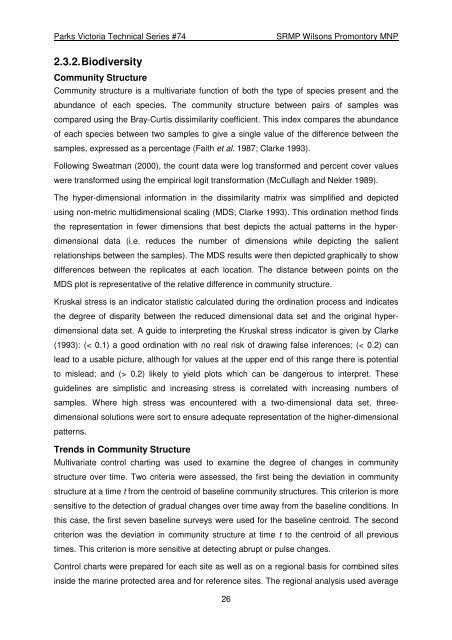the reef biota at Wilsons promontory marine national - Parks Victoria
the reef biota at Wilsons promontory marine national - Parks Victoria
the reef biota at Wilsons promontory marine national - Parks Victoria
- No tags were found...
You also want an ePaper? Increase the reach of your titles
YUMPU automatically turns print PDFs into web optimized ePapers that Google loves.
<strong>Parks</strong> <strong>Victoria</strong> Technical Series #74SRMP <strong>Wilsons</strong> Promontory MNP2.3.2. BiodiversityCommunity StructureCommunity structure is a multivari<strong>at</strong>e function of both <strong>the</strong> type of species present and <strong>the</strong>abundance of each species. The community structure between pairs of samples wascompared using <strong>the</strong> Bray-Curtis dissimilarity coefficient. This index compares <strong>the</strong> abundanceof each species between two samples to give a single value of <strong>the</strong> difference between <strong>the</strong>samples, expressed as a percentage (Faith et al. 1987; Clarke 1993).Following Swe<strong>at</strong>man (2000), <strong>the</strong> count d<strong>at</strong>a were log transformed and percent cover valueswere transformed using <strong>the</strong> empirical logit transform<strong>at</strong>ion (McCullagh and Nelder 1989).The hyper-dimensional inform<strong>at</strong>ion in <strong>the</strong> dissimilarity m<strong>at</strong>rix was simplified and depictedusing non-metric multidimensional scaling (MDS; Clarke 1993). This ordin<strong>at</strong>ion method finds<strong>the</strong> represent<strong>at</strong>ion in fewer dimensions th<strong>at</strong> best depicts <strong>the</strong> actual p<strong>at</strong>terns in <strong>the</strong> hyperdimensionald<strong>at</strong>a (i.e. reduces <strong>the</strong> number of dimensions while depicting <strong>the</strong> salientrel<strong>at</strong>ionships between <strong>the</strong> samples). The MDS results were <strong>the</strong>n depicted graphically to showdifferences between <strong>the</strong> replic<strong>at</strong>es <strong>at</strong> each loc<strong>at</strong>ion. The distance between points on <strong>the</strong>MDS plot is represent<strong>at</strong>ive of <strong>the</strong> rel<strong>at</strong>ive difference in community structure.Kruskal stress is an indic<strong>at</strong>or st<strong>at</strong>istic calcul<strong>at</strong>ed during <strong>the</strong> ordin<strong>at</strong>ion process and indic<strong>at</strong>es<strong>the</strong> degree of disparity between <strong>the</strong> reduced dimensional d<strong>at</strong>a set and <strong>the</strong> original hyperdimensionald<strong>at</strong>a set. A guide to interpreting <strong>the</strong> Kruskal stress indic<strong>at</strong>or is given by Clarke(1993): (< 0.1) a good ordin<strong>at</strong>ion with no real risk of drawing false inferences; (< 0.2) canlead to a usable picture, although for values <strong>at</strong> <strong>the</strong> upper end of this range <strong>the</strong>re is potentialto mislead; and (> 0.2) likely to yield plots which can be dangerous to interpret. Theseguidelines are simplistic and increasing stress is correl<strong>at</strong>ed with increasing numbers ofsamples. Where high stress was encountered with a two-dimensional d<strong>at</strong>a set, threedimensionalsolutions were sort to ensure adequ<strong>at</strong>e represent<strong>at</strong>ion of <strong>the</strong> higher-dimensionalp<strong>at</strong>terns.Trends in Community StructureMultivari<strong>at</strong>e control charting was used to examine <strong>the</strong> degree of changes in communitystructure over time. Two criteria were assessed, <strong>the</strong> first being <strong>the</strong> devi<strong>at</strong>ion in communitystructure <strong>at</strong> a time t from <strong>the</strong> centroid of baseline community structures. This criterion is moresensitive to <strong>the</strong> detection of gradual changes over time away from <strong>the</strong> baseline conditions. Inthis case, <strong>the</strong> first seven baseline surveys were used for <strong>the</strong> baseline centroid. The secondcriterion was <strong>the</strong> devi<strong>at</strong>ion in community structure <strong>at</strong> time t to <strong>the</strong> centroid of all previoustimes. This criterion is more sensitive <strong>at</strong> detecting abrupt or pulse changes.Control charts were prepared for each site as well as on a regional basis for combined sitesinside <strong>the</strong> <strong>marine</strong> protected area and for reference sites. The regional analysis used average26

















